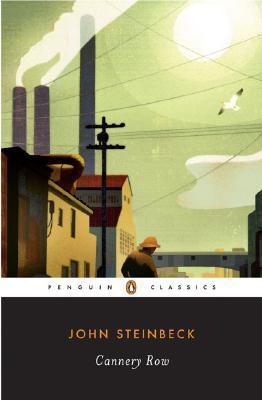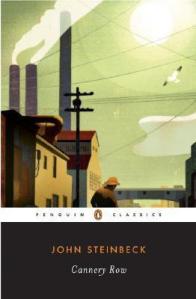Roof Beam Reader
Adam Burgess
Review: Cannery Row by John Steinbeck

Cannery Row by John Steinbeck
Final Verdict: 4.0 out of 4.0
YTD: 54
Plot/Story:
4 – Plot/Story is interesting/believable and impactful (socially, academically, etc.)
Cannery Row is a unique stand-out amongst Steinbeck’s works, for many reasons. One of these is that, unlike with East of Eden, Grapes of Wrath, or Of Mice and Men, for example, there is not much of a plot. Instead, what Steinbeck does is open up to his readers a place – typically American (and Californian)- where its people and its mood can be felt, captured, and understood. This place is Cannery Row, a small cannery district in Monterey, California. The people are a mix of shop-owners, layabouts, migrant workers, “girls for hire,” and others who are either genuinely worn down or who have chosen to live humbly in this out-of-the-way town, rather than move on up to the more prosperous areas. The story itself centers on a man named Mack and his group of pals, all of whom are without work but who get by on their resourcefulness and their ability to find work when it becomes absolutely necessary. The gang decides to do something nice for the town doctor, who does so much for the town without ever asking for anything in return. Their first attempt at ‘thanking’ him goes terribly wrong, but they vow to make up for it and, in the end, they succeed. Their gift to the doctor brings everyone together but, what the reader will realize, is that amongst the friendship and revelry is a deep sadness and loneliness which both the town and its inhabitants, but particularly the doctor, suffer from.
Characterization:
4 – Characters extraordinarily well developed.
Cannery Row is similar to The Grapes of Wrath in that the main story is frequently interrupted by short vignettes. In Grapes of Wrath, these intercalary chapters served to widen the lens from the Joad family and onto the plight of the Great Depression and migrant workers in general. Here, in Cannery Row, the interruptions often introduce the reader to minor characters – residents of or visitors to the town who emphasize certain extremities of real life, most of which are cruel in nature (dead bodies, violence, suicide, etc.). Many readers are critical of Steinbeck’s method of interrupting the primary story in this way, but the purpose is to shape a world, to give feeling and context to a group of people, without having to focalize on one person or one family in particular. This allows the story to be about a general community rather than individuals, which allows the conversation to be about a class or type of people, a region, rather than a character – the place, in fact, becomes the person. This is what regionalists (like Faulkner) do best. In addition to this, the specific characters who are introduced and witnessed, such as Mack, Doc, and Lee Chong, the shop owner, are all distinct, realistic, and purposeful. Their interactions with one another are interesting and believable, but their internal thought processes are perhaps the most fascinating of all.
Prose/Style:
4 – Extraordinary Prose/Style, enhancing the Story.
I am a fan of Steinbeck’s prose. In this book, he opens many of the chapters with incredible descriptions – short passages that are almost poetic in their beauty. He has a talent for not just seeing but also feeling people and places, then somehow reimagining these sensations into written language. While Steinbeck employs an intercalary method, as mentioned above, his narrative asides and detours are brief and his description of those things taking place outside of the primary story are shortened. While we might leave the main story from time-to-time, it does not feel, as it sometimes does with Grapes of Wrath, as if we have been completely separated from it. Steinbeck also manages to capture mood and tone with his narrative voice and through his use of dialogue. We learn much about the character Frankie, for instance, without necessarily being granted access to Frankie’s point of view. Instead, we learn about him through others’ treatment of him, through Steinbeck’s description of him, and by the way his and the Doctor’s relationship is presented in the narrative – subtle descriptions and meaningful allusions. Frankie, one single character, comes to mean much more on the narrative level. He represents a type of person but, due to the straightforward and bare, sometimes raw, way Steinbeck approaches his descriptions, he can represent a group of people without becoming a grotesque. Ultimately, the prose and style are generally sparse with brief interludes of poetic, almost romantic language. The style suits the tone of the novel as well as the nature of its characters and “plot” or, more accurately, situation.
Additional Elements: Setting, Symbols/Motifs, Resolution, etc.
4 – Additional elements improve and advance the story.
Cannery Row, unlike many of Steinbeck’s other works, is not quite as politically charged or socially sentimental. It is still about people and place, exactly what one would expect from such a brilliant regionalist writer, but its purpose is much more ambiguous. The emotion and pathos is still there, but the reader is allowed simply to bear witness to a community, perhaps even becoming a part of it, without necessarily being guided toward feeling one way or another about anyone in the town (even the Doctor, lauded by his townspeople, has his faults). Certain themes from Steinbeck’s other works, such as mental health, community-families, survival, depression (economic and psychological), and labor are present again in this book, but in a much more subtle way. For those who enjoy Steinbeck but who might be put off by his “peachiness” or heavy-handedness of politics/morality, Cannery Row might be exactly what you are looking for. There is also a good amount of humor, counterbalancing a relatively sombre tone.
Suggested Reading for:
Age Level: High School+
Interest: Great Depression, Community, Loneliness, Mental Health, American West, Friendship, Society
Notable Quotes:
“Cannery Row in Monterey in California is a poem, a stink, a grating noise, a quality of light, a tone, a habit, a nostalgia, a dream.” (5)
“Man’s right to kill himself is inviolable, but sometimes a friend can make it unnecessary.” (13)
“Casting about in Hazel’s mind was like wandering alone in a deserted museum.” (34)
“It is the hour of the pearl – the interval between day and night when time stops and examines itself.” (82)
“The things we admire in men, kindness and generosity, openness, honesty, understanding and feeling are the concomitants of failure in our system. And those traits we detest, sharpness, greed, acquisitiveness, meanness, egotism and self-interest are the traits of success. And while men admire the quality of the first they love the produce of the second.” (135)

Amazing analysis of this important work. Thank you for opening up my eyes (and mind) to seeing more of it.
LikeLike
I adore this book. After reading most of Steinbeck’s work I came across this gem and just fell in love. You must go read Sweet Thursday, the sequel to Cannery Row, as soon as you can!
LikeLike
Thanks for the suggestion – I’ll get on that ASAP!
LikeLike
The first Steinbeck book I have read. I used to live in the area so I picked it up mainly because of that, but it accomplished something I didn’t expect it to: It hit me pretty hard.
LikeLike
I adore Steinbeck, but this one surprised me, too.
LikeLike
This is one of my favorite Steinbeck novellas/shorts. Great review!
LikeLike
Confession: I have not read any Steinbeck! It’s true! You have inspired me to change that and I am now pretty excited to read some of his works. Great review!
LikeLike
I haven’t read this book but I liked so much Grapes of Wrath and The pearl, although they make you feel.. well, they make you feel depressed I think.
I didn’t know this book, but I’ll look for it in second hand shop books.
LikeLike
wonderful review, never read any of Steinbeck\s novels. I will be on the lookout for a copy
LikeLike
great!
LikeLike